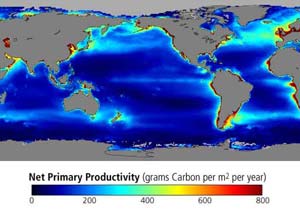Ocean Plant Life Slows down and Absorbs Less Carbon

Distributions of Ocean Net Primary Productivity (1997-2002) <br> <br>The image shows ocean net primary productivity distributions from the Sea-viewing Wide Field-of-view Sensor (SeaWiFS) data on the OrbView-2 satellite (1997-2002). The units are in grams of Carbon per meter squared per year. Light gray areas indicate missing data. Credit: Images by Robert Simmon, NASA GSFC Earth Observatory, based on data provided by Watson Gregg, NASA GSFC.
Plant life in the world’s oceans has become less productive since the early 1980s, absorbing less carbon, which may in turn impact the Earth’s carbon cycle, according to a study that combines NASA satellite data with NOAA surface observations of marine plants.
Microscopic ocean plants called phytoplankton account for about half the transfer of carbon dioxide (CO2) from the environment into plant cells by photosynthesis. Land plants pull in the other half. In the atmosphere, CO2 is a heat- trapping greenhouse gas.
Watson Gregg, a NASA GSFC researcher and lead author of the study, finds that the oceans’ net primary productivity (NPP) has declined more than 6 percent globally over the last two decades, possibly as a result of climatic changes. NPP is the rate at which plant cells take in CO2 during photosynthesis from sunlight, using the carbon for growth. The NASA funded study appears in a recent issue of Geophysical Research Letters.
“This research shows ocean primary productivity is declining, and it may be a result of climate changes such as increased temperatures and decreased iron deposition into parts of the oceans. This has major implications for the global carbon cycle,” Gregg said. Iron from trans-continental dust clouds is an important nutrient for phytoplankton, and when lacking can keep populations from growing.
Gregg and colleagues used two datasets from NASA satellites: one from the Coastal Zone Color Scanner aboard NASA’s Nimbus- 7 satellite (1979-1986); and another from Sea-viewing Wide Field-of-view Sensor data on the OrbView-2 satellite (1997- 2002).
The satellites monitor the green pigment in plants, or chlorophyll, which leads to estimates of phytoplankton amounts. The older data was reanalyzed to conform to modern standards, which helped make the two data records consistent with each other. The sets were blended with surface data from NOAA research vessels and buoys to reduce errors in the satellite records and to create an improved estimate of NPP.
The authors found nearly 70 percent of the NPP global decline per decade occurred in the high latitudes (above 30 degrees). In the North Pacific and North Atlantic basins, phytoplankton bloom rapidly in high concentrations in spring, leading to shorter, more intense lifecycles. In these areas, plankton quickly dies and can sink to the ocean floor, creating a potential pathway of carbon from the atmosphere into the deep ocean.
In the high latitudes, rates of plankton growth declined by 7 percent in the North Atlantic basin, 9 percent in the North Pacific basin, and 10 percent in the Antarctic basin when comparing the 1980s dataset with the late 1990s observations.
The decline in global ocean NPP corresponds with an increase in global sea surface temperatures of 0.36 degrees Fahrenheit (F) (0.2 degrees Celsius (C)) over the last 20 years. Warmer water creates more distinct ocean layers and limits mixing of deeper nutrient-rich cooler water with warmer surface water. The lack of rising nutrients keeps phytoplankton growth in check at the surface.
The North Atlantic and North Pacific experienced major increases in sea surface temperatures: 0.7 degrees C (1.26 F) and 0.4 degrees C (0.72 F) respectively. In the Antarctic, there was less warming, but lower NPP was associated with increased surface winds. These winds caused plankton to mix downward, cutting exposure to sunlight.
Also, the amount of iron deposited from desert dust clouds into the global oceans decreased by 25 percent over two decades. These dust clouds blow across the oceans. Reductions in NPP in the South Pacific were associated with a 35 percent decline in atmospheric iron deposition.
“These results illustrate the complexities of climate change, since there may be one or more processes, such as changes in temperature and the intensity of winds, influencing how much carbon dioxide is taken up by photosynthesis in the oceans,” said co-author Margarita Conkright, a scientist at NOAA’s National Oceanographic Data Center, Silver Spring, Md.
Other recent NASA findings have shown land cover on Earth has actually been greening. For information and images on the Internet, visit: www.nasa.gov/home/hqnews/2003/jun/HQ_03182_green_garden.html
Media Contact
All latest news from the category: Ecology, The Environment and Conservation
This complex theme deals primarily with interactions between organisms and the environmental factors that impact them, but to a greater extent between individual inanimate environmental factors.
innovations-report offers informative reports and articles on topics such as climate protection, landscape conservation, ecological systems, wildlife and nature parks and ecosystem efficiency and balance.
Newest articles

Innovative 3D printed scaffolds offer new hope for bone healing
Researchers at the Institute for Bioengineering of Catalonia have developed novel 3D printed PLA-CaP scaffolds that promote blood vessel formation, ensuring better healing and regeneration of bone tissue. Bone is…

The surprising role of gut infection in Alzheimer’s disease
ASU- and Banner Alzheimer’s Institute-led study implicates link between a common virus and the disease, which travels from the gut to the brain and may be a target for antiviral…

Molecular gardening: New enzymes discovered for protein modification pruning
How deubiquitinases USP53 and USP54 cleave long polyubiquitin chains and how the former is linked to liver disease in children. Deubiquitinases (DUBs) are enzymes used by cells to trim protein…



